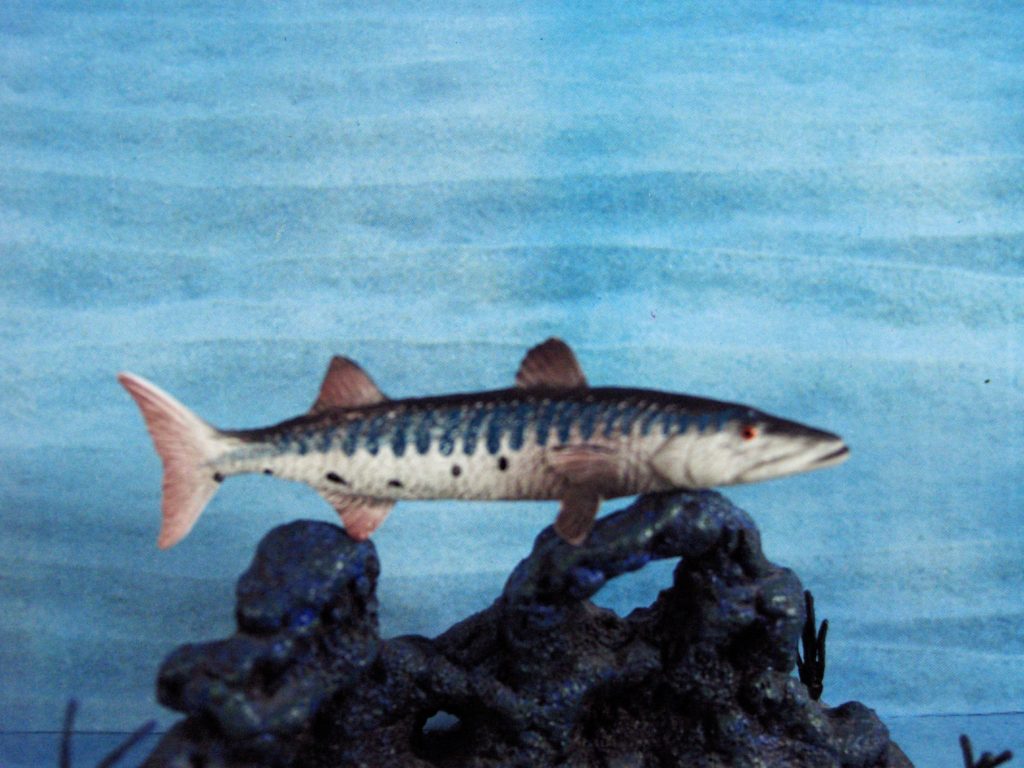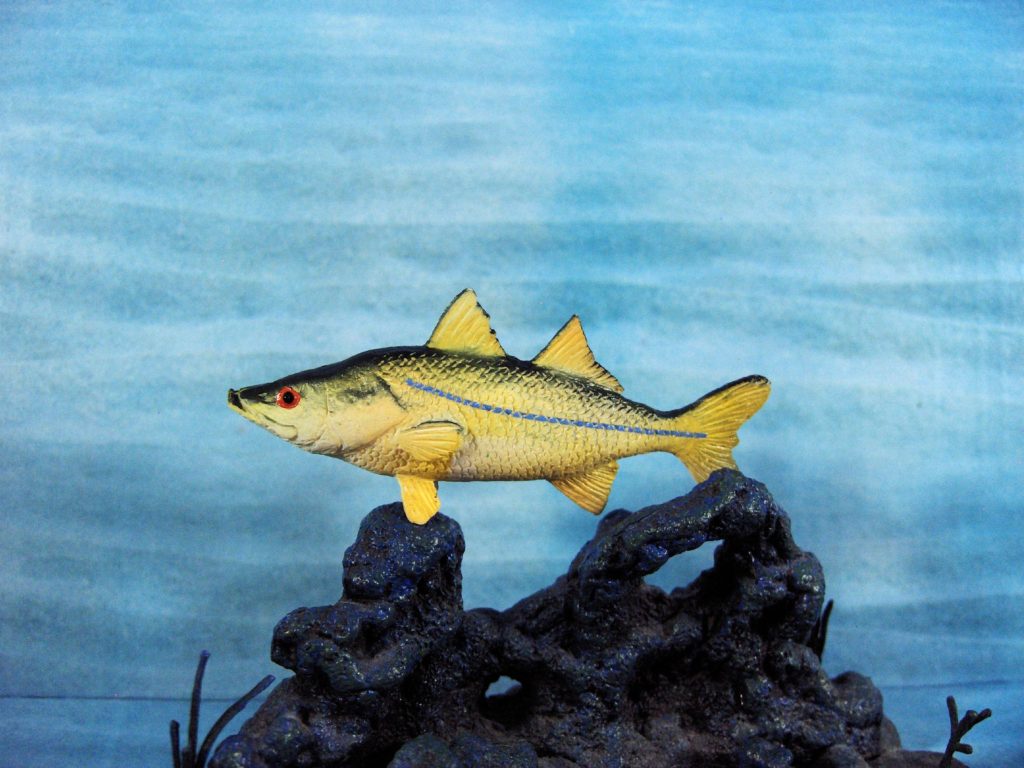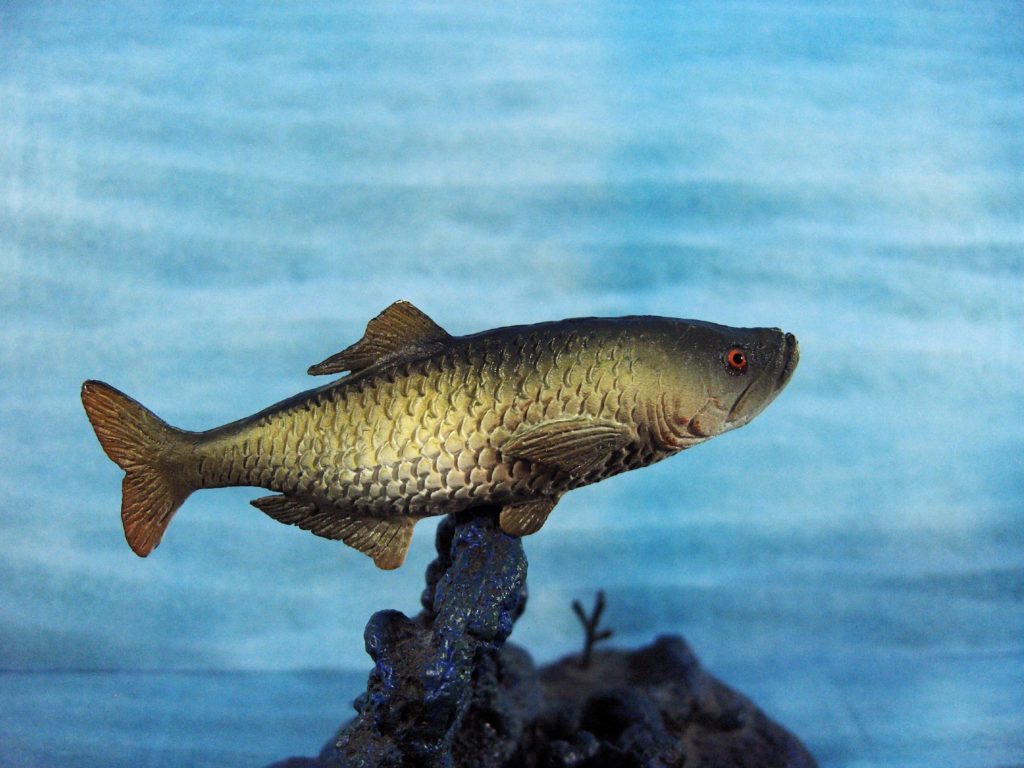So, after a long hiatus (sorry about that) I have finally gotten myself writing again–and of course it’s fish! Recently the company Toy Fish Factory released two new sets, a Gulf Coast fishes and a Northern Angler set. 2 sets were released previously, the American Angler and River Monsters.
For those who are unaware, I will give a bit of background, and then I’ll discuss each figure in detail–they are all small, and generally wouldn’t warrant a full write up each. Toy Fish Factory is the second company to come out of the mind of an angling and fish fan in Colorado. His first company, Replica Toy Fish (RTF), had a run for about 10 years or so, but production and supply problems plagued him. So he started fresh, deciding to branch out a little from his original focus on North American freshwater sport fish, and called it Toy Fish Factory (TFF). Admittedly, the series is still primarily sport-fish focused, and continues to lean more to North America. But when (if?) the full series of 20 planned sets comes out, it will be a huge boost to the representation of freshwater fish toys, which are generally overlooked as far as figures go (beyond fish in general, which tend to favor reef and deep sea animals).

The original RTF fish were mainly released as single, bulk fish. In some ways this was great–you (or a vendor) could stock up on the ones you liked most–but for production, this could mean some were left behind. It also meant even basic things, like name tags or branding, were unavailable. With the TFF line, the figures are only available in a small 5-compartment tackle box (I am guessing some sellers will split them up, but I think that might not be a great idea…). This allows the brand to be present, as well as the basic minimum of identifying the fish for the consumer; I would have liked to see a bit more info on each species, maybe on a back sticker, but that’s just me. It also means it is easier for a store to put them up for sale–they have hangers on the boxes, and present well on a shelf. Of course, the shape of the container spaces means we probably won’t see rays or flounders any time soon!
Now, to the individual fish. For these, I am just doing one image of each. As a standard, TFF figures are straight and flat–no poses, no stands, no curves or twists or bends. They’re kind of like 3D field guide–the fish are set up as idealized examples, but still very close to life appearance. So both sides are pretty uniform, although the paint can vary a bit from side to side. All of the figures are about the same length, roughly 7.5-6.5 cm long each, but of course the scale varies widely depending on the species.
To the FISH! (in order of appearance on the box art)
1. Barracuda (assumed Great Barracuda, Sphyraena barracuda) (Edwards in Catesby, 1771)

- Length: 7.1 cm
- Scale: about 1:24
- Uniqueness: Unsurprisingly, barracuda have been made as figures before, in bin sets, by Kaiydo, by MPC. Not as frequently as one might expect for such a well-known predator
- Comments: It’s a pretty good figure. It’s a little thicker than I’m familiar with for barracuda, but gets a good sense of the long, streamlined body. The ID of Great Barracuda comes from the heavy body, as well as the bars down the sides. However, the reddish fins seems a bit exaggerated.
- Display worthy? I would say yes. I have a Kaiyodo of course, but there’s room for two, and it’s a nice figure.
2. Common Snook Centropomus undecimalus (Bloch, 1792)

- Length: 6.2cm
- Scale: 1:23
- Uniqueness: Despite the popularity as a game fish…I don’t know for sure of any true Common Snook figures. I know that ‘snook’ is used as a vernacular for several other types of fish, but this is the only Centropomus one I am aware of. Fun fact–Yujin made a series of freshwater fish, and one of them, the Barramundi, will often translate as ‘snook’ in Japanese auctions. Just so you know.
- Comments: It seems a bit more golden than in real life, where the fish tend to be very shiny silver. And the red eye (a theme with these fish) is a little distracting. But they overall shape and markings were captured well.
- Display worthy? As a unique species for a fish collector, definitely. But for a more casual collector, this one might get stored.
3. Redfish (more commonly known as Red Drum). Sciaenops ocellatus (Linnaeus, 1766)

- Length: 6.2 cm
- Scale: 1:16
- Uniqueness: I am only aware of generic drum (fish) figures from bin sets. So it’s at least different.
- Comments: Like the previous Snook, some liberties were taken with the colours palette here, adding more red in blotches, rather than a more muted reddish wash. They did, however, do a good job of capturing the eye spot at the base of the tail, so that’s kind of neat.
- Display worthy? I will. Other fish people will. Again, it’s not an impressive fish in some regards, but interesting as a different fish. Or maybe I’m just influenced by my bias against perciform fish, which I find less impressive than, say bichirs and other oddballs!
4. Speckled Trout (better known as Spotted Seatrout) Cynoscion nebulosus (Cuvier in Cuvier & Valenciennes, 1830)

- Length: 6.5cm
- Scale: 1:7.5
- Uniqueness: I can honestly say that I am unaware of any seatrout figures. I say this, but it is possible that one of the more obscure fish sets, like from Prior or Azur, could make figures of these (or other species from this set) and I wouldn’t know–those companies don’t mark their figures either!
- Comments: This figure has done a good job of capturing the patterns and shading seen on the fish, but again the yellow and red is exaggerated. In a way I don’t blame them, otherwise the whole set would be 5 silver fish with different spots. Unless they went with mainly breeding colours? I don’t know. Stands out though.
- Display worthy? I would say yes. It’s a very different fish, the whole ‘trout’ thing could be a conversation started (for a very weird conversation…or a very specific one) and it’s got some eye-catching colour.
5. Atlantic Tarpon Megalops atlanticus Valenceinnes, 1847

- Length: 6.9cm
- Scale: 1:23
- Uniqueness: I’ll be honest, this species was the most exciting for me. I have been waiting for a tarpon for soooo long. They are widely distributed and well-known, plus they have that primitive look, but there’s never been a figure before.
- Comments: This is probably the only fish of these 5 that I can speak to personally–I’ve swam with tarpon, and watched small ones swim around my feet. It’s, again, not as silvery as it could be, but they can have an almost gold or brassy sheen, so the yellow isn’t so out of place. The trailing end off the dorsal fin could stand to be longer, but like catfish whiskers there’s a trade off between realism and feasibility.
- Display worthy? Absolutely. I mentioned that it’s the only model of a tarpon, but it’s also the only model of any Elopomorph fish that isn’t an eel or gulper eel (if that matters to you. It matters to me!) So it should be shown off. Like the barracuda, it’s very distinct.
Final thoughts: Overall, I would call this set a definite win. Unique species, or at the least well-defined species, in a set that should appeal to kids, collectors, and fans of open-sea fishing. I am hopeful that the new style and packaging is appealing to retailers as well, since getting these into stores will help push the company to make more of their planned models (I may be the only one that wants a Goldeye, but I really need to see that happen). And, while I don’t normally, I do want to point out that I do have all four sets for sale on my site, or you can go direct from Toy Fish Factory. However you get them, make sure to get them!
Disclaimer: links to Ebay and Amazon on the AnimalToyBlog are affiliate links, so we make a small commission if you use them. Thanks for supporting us!




When this set was announced on the TFF site one of the first things I thought of was: I hope Sean does a review on the Blog!
I bought this set, for my Synoptic Collection (although I won’t retain the barracuda since I have a nice Kaiyodo figure).
It is an impressive set and I feel the paint, while exaggerated in places, is getting better than what we saw in the River Monsters and American Anglers sets (esp. the former).
I would have to agree re: the River Monsters (which I’ll get to eventually). The species choices were good, but the stylization in the paint schemes is almost cartoonish.